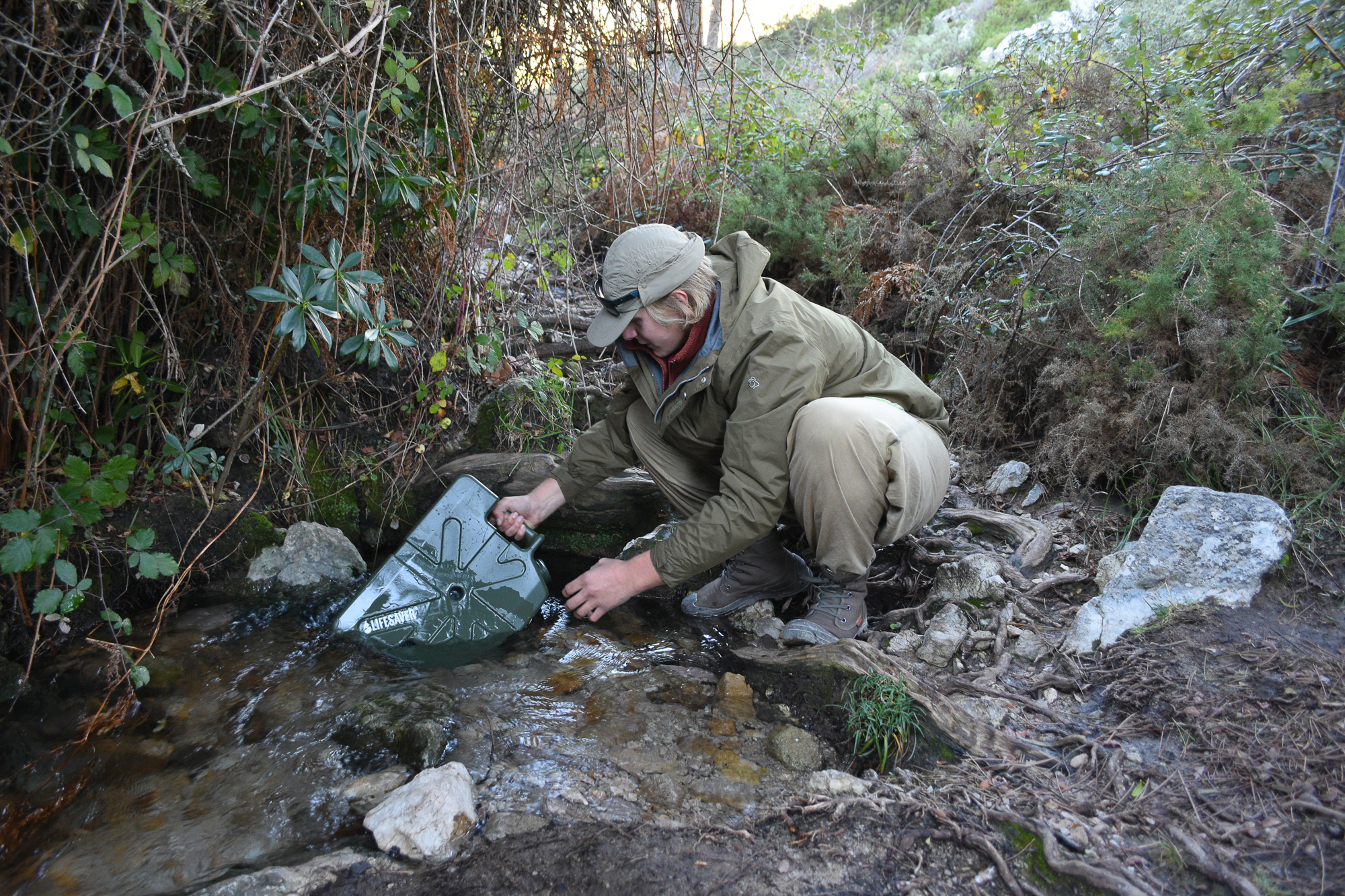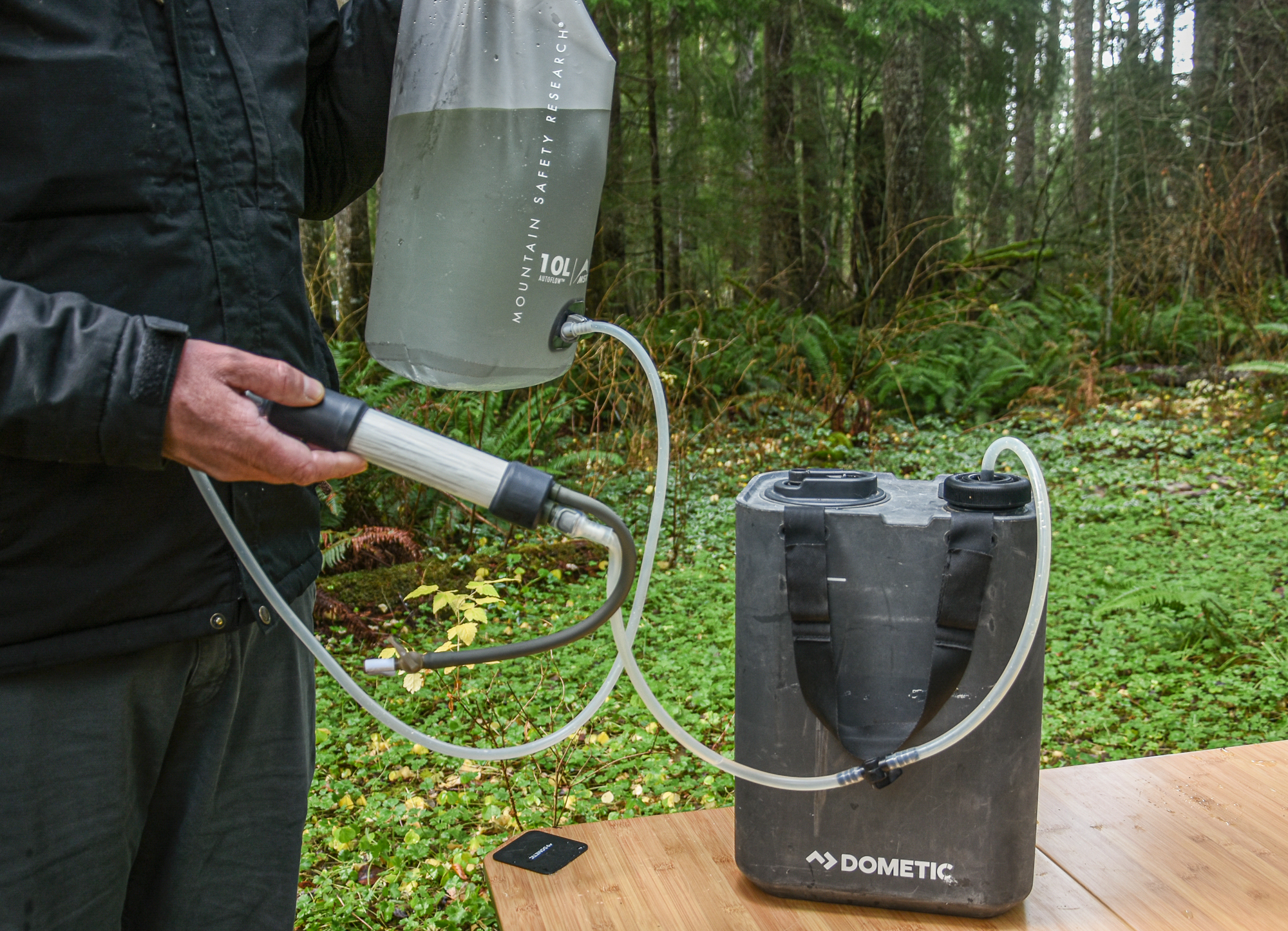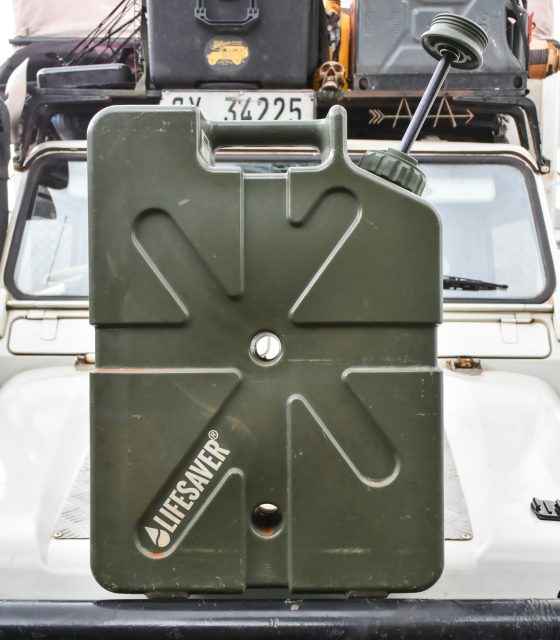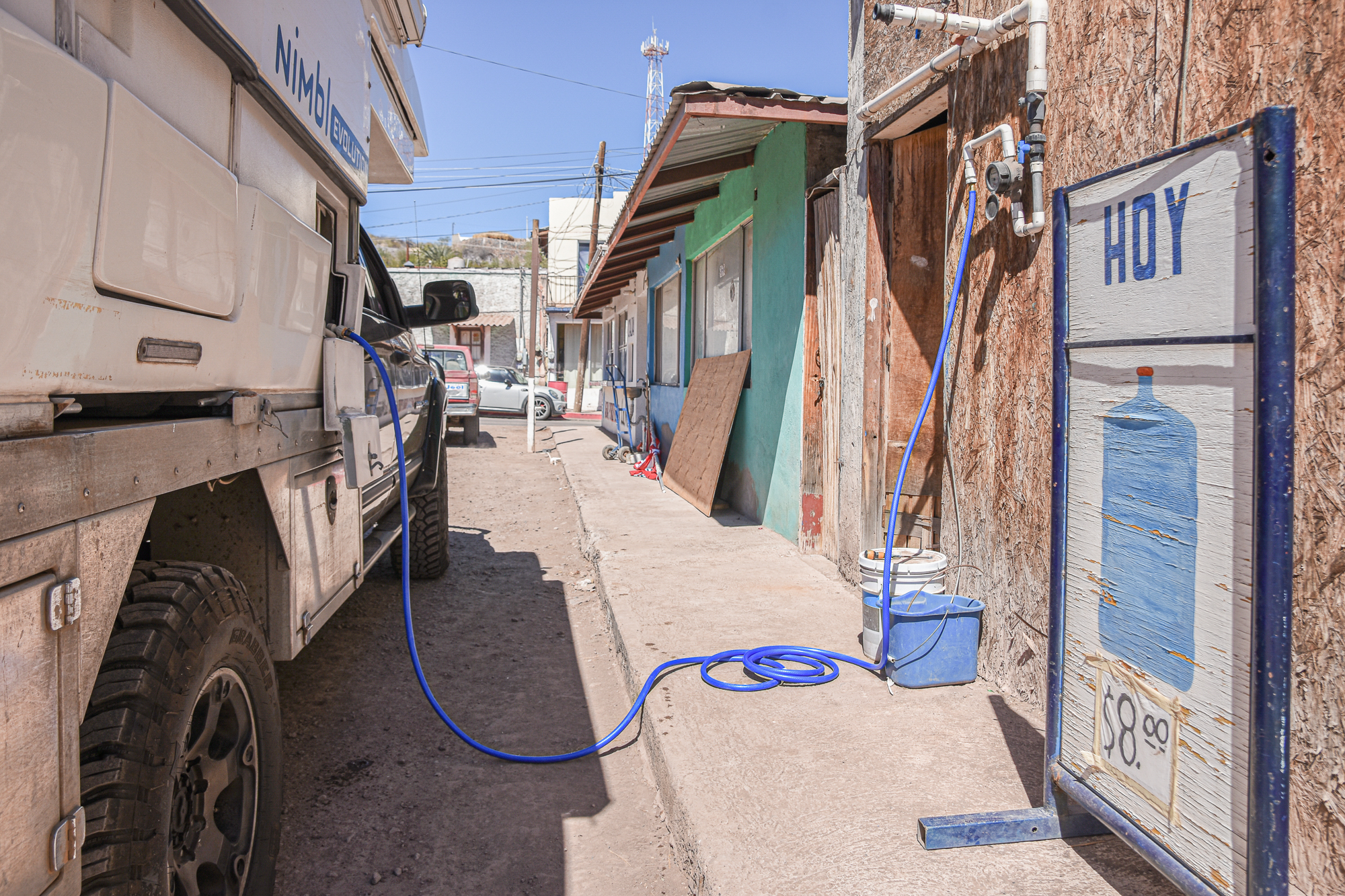Editor’s Note: This article was originally published in Overland Journal’s Gear 2023 Issue.
Camped beside a road in Ivory Coast, I filtered soupy rainwater from an old plastic barrel. I trusted my system but had to wonder—was the hard-working filter up to the task of removing chemicals, bacteria, and viruses? Was I hydrating my family with contaminated water despite my best efforts?
Water is life, and every overland traveler knows that the storage and consumption of safe, reliable water are essential components to your health and a successful journey. When consumed, improperly stored and treated water may lead to illnesses ranging from mild to severe. The outdoor and adventure accessory market overflows with products that promise the solution to clean, potable water, but often those products are not used correctly or are substandard. In consultation with Owen Mesdag, current product manager for Dometic and former senior product designer at Mountain Safety Research (MSR), we have broken down the water sourcing, filtration, and storage process.

My son, Keegan, gathering and filtering water using the Lifesaver 20,000UF after a vehicle breakdown in the Rif Mountains of Morocco. We were stranded for four days and lucky to find a nearby spring for filtration.
Water-borne Illnesses
Significant short-term threats include bacteria (E.coli, salmonella, hepatitis A), protozoa (giardia, cryptosporidium), parasites, and viruses (rotavirus, norovirus, etc.). Effects can be immediate, and their impact on health is one of the greatest risks for an overland traveler. These threats are easily removed by the diligent use of filters and purifiers.
Long-term health concerns from exposure to chemicals, pesticides, heavy metals (lead, mercury, arsenic, etc.), and volatile organic compounds (VOCs) can result from the sustained and continuous consumption of contaminated water. It stands to reason that there would be short-term effects as well. Your water storage and filtration process should address and eliminate the majority of these hazards; activated carbon filters, in particular, are good at reducing these elements.
Microfiltration and Ultrafiltration
Effective filtration can be achieved through various processes, including running water through sand, clay, filter presses, or sedimentation. Microfiltration removes bacteria and suspended solids through the use of micro-porous membranes, while ultrafiltration removes viruses via more pressure and semipermeable membranes. The microfiltration and ultrafiltration processes we investigated range from hollow-fiber membranes, porous ceramic filters, or adsorption media such as granular activated carbon (GAC) to filter or separate contaminating substances from the water.
Membrane and ceramic filters are semi-permeable materials that utilize size exclusion to allow various particle sizes to either flow through or be trapped by the membrane. The degree of separation largely depends on particle size and membrane density (these processes will be discussed in detail below). Membrane filtration can remove various items such as particulates (dirt), bacteria, viruses, and organic material but will not remove color, taste, or chemicals. GAC, or carbon filtration, assists in improving odor and taste. When using bleach to purify water, carbon filters quickly become ineffective. Only when the water becomes foul-tasting will you realize that the carbon filter needs to be replaced.

Illustrated in micrometers (microns), this chart depicts the particle sizes of common objects and particulates and serves as a comparison chart for filtration from visible to microscopic contaminants.
The Four Steps to Potable Water
Step 1: Sourcing
Sourcing the cleanest water possible is essential. In our travels, we have found that many towns and cities have water treatment and sterilization facilities where municipal water is further processed and dispensed by hose or in 5-gallon bottles. Affordable and safe, we fill our water tanks at these places as often as possible. Occasionally, we have to source water directly from the municipal supply or a freshwater stream, well, or river.
Beware when sourcing unsterilized water, as its crystal-clear appearance is not an indicator of safety. Bacteria and viruses invisible to the naked eye can hide in plain sight and in the shadow of impurities, which means your ultraviolet water filter is perhaps not as effective as you might imagine. Clear water is only the first step in the process, and many filters are designed only to remove impurities and improve the taste.
Consider the following when sourcing water.
- Hoses should be flushed before being used, as chemicals in plastic hoses will contaminate standing water (an example of a long-term threat).
- Water from streams or rivers should be collected from the deepest area possible or where the water is mostly clear and free from debris. Flowing water is safest; above the river bed and a few inches below the surface is best.
- Avoid stagnant water.
- Well water may seem clean but is often unreliable as local pollution of groundwater through industrial or agricultural practices may not be apparent but should be assumed.
- Municipal water is generally safe, depending on the country, and is treated with chlorine and fluoride, which are best removed with an activated carbon filter.
- Rainwater is usually pretty clean, but the surface or container it is collected from is likely not, resulting in contamination.
Step 2: Filter Particles by Microfiltration
Ideally, water should be sourced using a temporary storage solution such as a water bag and then filtered through a 0.1-micron filter (a 0.2-micron pore size is more common on available microfilters and is still effective) into a sterilized storage container. The filter will remove coarse particles, visible to the naked eye, from the size of beach sand to fine-milled flour (see chart) and will render the water transparent, improve taste, and prepare the water for the next stage of filtration. A 0.1-0.2 micron filter will remove some, but not all, bacteria and will not remove all viruses, lead, or heavy metals, but it is generally considered adequate preparation for consumption.
An all-too-common practice in the field is to filter dirty water entirely with a microfilter intended primarily for the removal of bacteria and particles. Remember, it is good practice to source water that is as clean as possible. By filtering large particles through such a filter, the user is blocking the filtration system, reducing its lifespan and effectiveness. It may be necessary to first let sourced water settle in a suitable container, allowing the majority of particulates to separate; this may take a few minutes. The water can then be “pre-filtered” through a suitable cloth (perhaps mutton or cheesecloth—even a clean sock will do) before beginning the process of microfiltration. If necessary, collapsible buckets and containers should be added to your water kit. Choosing water with the least amount of sediment is always the best choice and will prolong the microfilter’s life.
Examples of microfilters include MSR’s MiniWorks EX (ceramic) or Autoflow Gravity (hollow-fiber membrane). Other options include the Katadyn Vario and the Lifestraw Go.

A water bag is used to source, separate particulates through settlement, gravity feed, and filter water into a long-term storage container.
Step 3: Eliminate Viruses by Ultrafiltration
Ultrafilters (or purifier filters) have the same advantage as microfilters but are also effective against viruses.
Drinking and cooking water must be bacteria and virus free. According to the New York State Department of Health, “Boiling water kills or inactivates viruses, bacteria, protozoa, and other pathogens by using heat to damage structural components and disrupt essential life processes (e.g., denature proteins). Boiling is not sterilization and is more accurately characterized as pasteurization. Sterilization kills all the organisms present, while pasteurization kills those organisms that can cause harm to humans.”
Boiling water may inactivate viruses, bacteria, and protozoa, but contaminants like lead, nitrates, and pesticides are not affected by the boiling process. Boiling reduces the volume of water and therefore increases the concentration of these contaminants. It is best practice to bring water to a rolling boil for at least one minute; boil water for three minutes at elevations above 5,000 feet (1,500 meters).

A hand-held pump is more efficient than a gravity-fed filtration system as the user can determine the flow rate, limited only by the flow capacity of the filter.
This next stage of the filtration process is referred to as ultrafiltration and is achieved by using a filter with a recommended minimum pore size between 0.02 and 0.05microns. Once this process is completed, your water will be ready for consumption and storage. It is not necessary to filter bathing and washing water to this degree, but both consumable and “domestic” water should follow this process.
Examples of ultrafilter purifiers are the MSR Guardian and the LifeSaver Jerrycan. We used the Lifesaver Jerrycan 20000UF as we crossed West and Southern Africa and grew to trust and rely on it as our primary filter.
Step 4: Storage and Purification of Stored Water
The rule of thumb is to only store clean water, free of all particles, bacteria, and viruses. It is not necessary to employ ultrafiltration of bulk water if stored water is treated with the correct dose of sodium hypochlorite (aka bleach), and the water has been through the microfiltration process. Treatment with bleach is a surefire way to protect your clean, stored water source from possible cross-contamination and to reduce bio-growth. Unfortunately, bleach has a limited shelf life, and you should not treat your water with bleaches that are scented, color-safe, or have added cleaners. Aqua Research’s H2GO Purifier is a pocket-sized chlorine generator for treating small quantities of stored water, while the MSR SE200 Community Chlorine Maker is able to treat hundreds of liters safely. Both work by utilizing the process of electrolysis, passing an electric current through a saline “brine” which breaks down sodium chloride into chlorine. Chlorine is a natural element and an ingredient of bleach, while bleach is a solution and the product of combining chlorine and other chemicals. Both bleach and chlorine are highly effective water purifiers.

A Dometic Water Container and MSR SE200 Community Chlorine Maker. Chlorinator. Stored water treated with correct quantities of chlorine will remain stable for long periods of time.
The following should be considered when treating stored water with (chlorine) bleach of either 6 or 8.25 percent.
- Use the table below to determine how much bleach you will need for the amount of water to be stored. A 1/2 teaspoon of 8.25 percent bleach will safely treat 8 gallons of water.
- Stir, and let the water stand for half an hour. The water should have a slight chlorine odor. If not, repeat the dosage and allow it to stand for 30 more minutes. If the smell is too strong, dilute the clean filtered water from a clean container and let it stand. With practice, you will perfect the concentration.
Common household iodine can also be used for sterilization but does not kill parasites. You likely have a tube of iodine in your medicine cabinet or first aid kit. Add five drops of 2 percent tincture of iodine to each quart or liter of water that you are disinfecting. If the water is cloudy or colored, add 10 drops of iodine. Stir, and let the water stand for at least 30 minutes before use.

Use Water Sparingly
Water conservation is almost as important as effective water filtration to overlanders; the more careful you are with the use of your limited water resources, the longer you will be able to travel comfortably off-grid and the less effort you will need to expend on water filtration. This seemingly obvious suggestion can, in practice, be quite difficult for those raised in homes with indoor plumbing, where even today, water is not always considered a finite resource. How many of you leave the water running while you brush your teeth? Too many. The water supply in your rig is not connected to a faucet, and your habits will need to be adjusted.
Methods to Conserve Water
Use a Water Cup A cupful is enough to brush your teeth, wet your hair, and wash your face every morning. One 8-ounce cupful is sufficient drinking water per person per hour.
Rethink Personal Hygiene When on the road, you do not have to shower or bathe every day, which is actually better for your skin and hair. Go for a swim if you come across a river, stream, or ocean. Even eco-friendly soaps have adverse effects on bodies of water; have a soapless wash in freshwater sources when you can. Give your hair a rinse and enjoy the water. Yes, the first people you come into contact with after two weeks in the bush will smell you, but you can’t smell yourself, and neither can your family.
Pack Well and Avoid Laundry Choose clothing that resists dirt and cleans and drys easily. Per week on the summer road, you essentially only need two pairs of trousers, two pairs of shorts, four or five T-shirts, a zip-up hoodie, and eight pairs of comfortable underwear. If you plan to be off-grid for a few weeks, stuff a laundry bag with the soiled, rolled clothing in anticipation of returning to civilization. If you must do laundry on the trail, wash only what you need.
Cook and Wash Dishes with Less Water
A cup of rice (enough for a family of four) requires 2 cups of water, and a bag of spaghetti can be cooked with only 5 cups of water. Steaming vegetables requires only 1-2 cups of water and retains all the vitamins and nutrients. And, if you need an excuse to make a campfire, many delicious meat and vegetable meals can be prepared over hot coals.
Dishes use a lot of water, but there are a few things you can do to reduce your water use.
- Use compostable or disposable paper plates; this is not a long-term strategy.
- Use one pot or pan, cook in stages, and reheat the food before serving.
- Barbeque for breakfast, lunch, and dinner.
- Wipe dishes with a cloth or paper towel before washing.
For dishwashing, pour a tablespoon of biodegradable, eco-friendly soap into a cup and add 1/2 cup water. Dip the washing sponge into the mix and wash the dishes. To rinse, fill 1 cup with clean water and empty into a washed cup; repeat, then pour the water over the remaining dishes. Continue with this rinsing method until all the dishes are rinsed (they do not need to be 100 percent soap free), then dry with a kitchen towel and pack away.
Carry Plenty of Water (But Not Too Much)
We carry 30 gallons of water for a family of four, spread between a 5-gallon external jerry can and two 15-gallon internal tanks. When possible, we also like to carry a large store-bought 2- or 3-gallon bottle. This is enough water for up to a week if used sparingly.

The Lifesaver 20,000UF in service in the Ivory Coast.
And, yes, you can carry too much water. Water is heavy, and it moves around as you drive. A vehicle loaded with too much water has to work a lot harder.
Our No Compromise Clause: We carefully screen all contributors to ensure they are independent and impartial. We never have and never will accept advertorial, and we do not allow advertising to influence our product or destination reviews.
Read more: Feature Vehicle :: Land Rover Defender 110, “The Monster”


